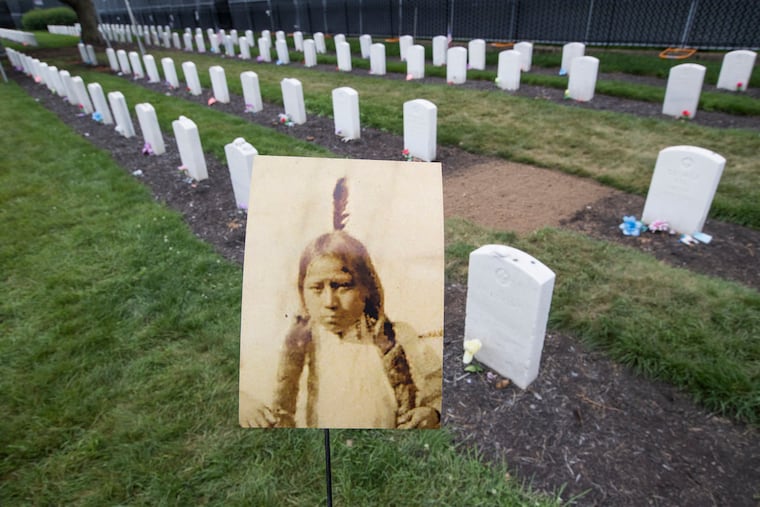Where is Little Plume? Indian boy's remains a mystery
In his grave were found the remains of two people, neither of them the 9-year-old Indian boy who died at the Carlisle Indian school in 1882.

CARLISLE, Pa . — Army officials fielded question after question Monday afternoon on the disinterment of three native children from the Indian school cemetery but had no answer for this one:
Where is Little Plume?
In his grave were found the remains of two people, neither of them the 9-year-old Indian boy who died here in 1882. The identities of his two friends, Little Chief and Horse, were identified by a forensic team based on the boys' age and sex.
The Northern Arapaho tribe, which sent representatives here to reclaim its lost kin, plans funerals in Wyoming this week.
"To find Little Plume, a lot more research is going to need to be done," said Michael "Sonny" Trimble, chief archaeologist of the Army Corps of Engineers. Television has made forensic work seem instant and easy, he added, when just the opposite is true.
Art Smith, head of Army national military cemeteries, said: "You never know what you're going to find until you open those grave sites. … That's all I can say to that."
Asked whether the discovery of two people in one coffin, neither of them Little Plume, dented his confidence in what other graves might hold, Smith said the Army does not have a pending request for disinterment by any tribe.
However, several tribes and families have said they're working on or considering seeking the return of the remains of children who died at the Carlisle Indian Industrial School, now the campus of the Army War College.
Forensic anthropologist Elizabeth DiGangi said Monday that when she realized the presumed remains of Little Plume included two bones from the hip area, both from the right side of the body, she and her assistant just looked at each other.
"These were kids," she said. "These were kids who went thousands of miles from home, and died thousands of miles from home. … Each one of those kids was the most loved person in the world for somebody else."
At the request of the tribe, the Army sought to exhume and return the remains of three Northern Arapaho children, all of whom, as was policy, were renamed at the school. Little Plume became Hayes Vanderbilt Friday, Little Chief was called Dickens Nor, and Horse was called Horace Washington.
The remains of Little Chief and Horse were returned to the tribe in private ceremonies Monday. The two new unknowns have been reburied at the cemetery.
The three boys' burial places, the Army said, were identified by headstones and historical records. But records have proven incomplete, and grave markers commonly contain partial or misspelled names, wrong dates of death, and missing birth dates. The cemetery was moved to its present location in 1927, in what native leaders have criticized as a haphazard job.
Last year researchers identified a 17-year-old boy named Fred War Bonnet, who died of tuberculosis and was buried in 1908 — but has no gravestone in the cemetery.
The graveyard contains stones marked "unknown," infuriating American Indian leaders, who question how a school that controlled its students' every movement could not know the names of those who died there.
Through painstaking, years-long analysis, and with help from fellow researchers, historian Barbara Landis has figured out the likely identities of at least seven of the unknowns. Her detective work is documented in the book Carlisle Indian Industrial School: Indigenous Histories, Memories, and Reclamations.
Landis scoured old issues of school newspapers to identify people who were buried in the old cemetery but have no named markers now.
Army officials have disputed some of those findings.
Yufna Soldier Wolf, the historic preservation officer for the Northern Arapaho, said Monday she was happy, "but I still feel like I have a lot to do."
The reburials are ahead, said Soldier Wolf, a great niece of Little chief, as are the sharing of the stories of the children and of the continuing impact of native boarding schools on tribes. "Everyone is finally learning about it, and acknowledging it," she said.
The aim of the nation's first federal off-reservation boarding school, founded by former Cavalry officer Richard Henry Pratt and run in military style, was to cleanse natives of their "savage nature" by erasing their names, languages, customs, religions and family ties. Beatings were common punishments. Even as children succumbed to tuberculosis and flu, Carlisle became the model for dozens of Indian schools that spread across the United States and Canada. Today Army officials said that in addition to human bones, which had been placed in small coffins for reburial in 1927, they found two buttons, apparently from a military-style shirt.